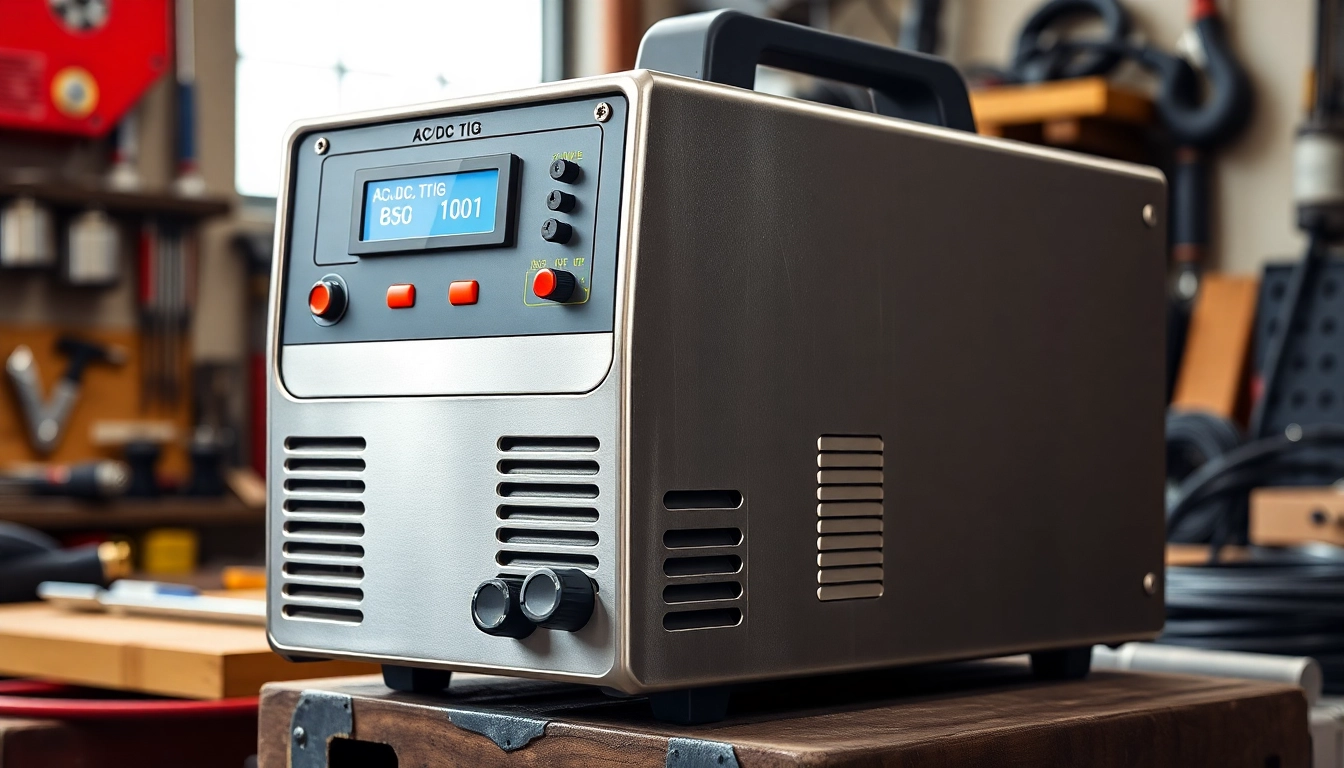Understanding AC DC TIG Welders
When it comes to mastering the art of welding, having the right equipment is paramount. Among the various options, ac dc tig welders stand out for their versatility and performance. Understanding the fundamental aspects of these machines can greatly enhance your welding skills and project outcomes.
What is an AC DC TIG Welder?
An AC DC TIG welder is a type of welding machine that uses both alternating current (AC) and direct current (DC) to perform Tungsten Inert Gas (TIG) welding. This dual-functionality allows users to work with a broader range of metals and thicknesses, making it suitable for various applications—from thin aluminum sheets to thicker stainless steel and mild steel projects. The TIG process is highly regarded for its ability to produce clean, precise, and high-quality welds, making it indispensable in industries such as aerospace, automotive, and fabrication.
Key Features to Look For in AC DC TIG Welders
When selecting an AC DC TIG welder, several features can influence your choice:
- Wattage and Power Output: Higher wattage allows for welding thicker materials and increases AC output for aluminum welding.
- Pulse Feature: Pulsed TIG welding capabilities enable better control over the heat input, which is crucial when working with thin materials.
- Digital Displays: A digital interface provides precise control over settings, ensuring the ability to fine-tune voltage and amperage.
- Foot Pedal Control: A foot pedal allows for hands-free operation, giving the welder complete control over the amperage while keeping both hands on the welding torch.
- Duty Cycle: The duty cycle indicates the amount of time a welder can be used continuously before needing to cool down, affecting productivity during extensive projects.
Common Applications of AC DC TIG Welding
The AC DC TIG welding technique is widely used across various fields:
- Aerospace Engineering: Due to its precision, TIG welding is ideal for creating strong, reliable welds in aerospace components.
- Automotive Industry: It’s often employed for welding exhaust components, frames, and body panels.
- Artistic Metalwork: Many artists and fabricators utilize TIG welding to create intricate designs and sculptures with high aesthetic quality.
- Pipe Welding: AC DC TIG welders are perfect for pipeline projects requiring clean and sturdy welds.
Benefits of Using AC DC TIG Welders
Opting for an AC DC TIG welder comes with numerous advantages that contribute to better welding experiences and results:
Versatility in Welding Different Metals
One of the key benefits of AC DC TIG welders is their versatility. They can successfully weld various metals, including:
- Aluminum: AC is particularly effective for aluminum, preventing oxide formation that usually complicates the welding process.
- Stainless Steel: DC current is commonly used for stainless steel, providing strong and corrosion-resistant welds.
- Carbon Steel: Both AC and DC are suitable, allowing for customization based on the project’s needs.
Precision and Control in Welding
The TIG welding process itself is designed to offer masterful control, which is enhanced with AC DC capabilities. Welders can adjust the heat input meticulously, allowing for:
- Better joint integrity, as it minimizes warping and distortion, especially important in thin metals.
- Aesthetic appeal, producing visually pleasing welds that require little to no post-weld cleanup.
Efficiency and Cost Savings
Investing in quality AC DC TIG welders can lead to efficiency gains:
- Reduced Waste: Precise heat control minimizes filler material waste.
- Energy efficiency: Advanced inverter technology provides better energy consumption rates compared to traditional welders.
- Faster Completion Times: Greater control leads to faster project completions without compromising quality.
Choosing the Right AC DC TIG Welder for Your Needs
Finding the ideal AC DC TIG welder entails careful consideration of your unique requirements and skill level. Here are some factors to keep in mind:
Considerations for Beginners
If you’re new to TIG welding, start by looking for welders that offer lower amp ranges and simple interfaces. Features to prioritize include:
- A user-friendly digital display for setting adjustments.
- Built-in tutorials or guides for proper setup and use.
- Warranty and customer support availability.
Features Recommended for Professionals
Professionals typically require more advanced features to produce high-quality work consistently. Consider welders that include:
- Extensive amperage range for tackling a variety of materials and thicknesses.
- Pulsing and remote control options for enhanced versatility during welding.
- Heavy-duty construction tailored to withstand rigorous use.
Comparing Brands and Models
Once you’ve narrowed down your requirements, cross-compare leading brands and models based on:
- Reputation and reliability based on customer feedback and expert reviews.
- Price point versus features offered.
- Support options, including availability of parts and service.
Maintenance and Care for Your AC DC TIG Welder
Proper maintenance is critical to ensure the longevity and performance of your AC DC TIG welder. Incorporating routine care can maximize your investment:
Routine Maintenance Tips
Establish a regular maintenance schedule that includes:
- Regular inspection of cables, hoses, and connectors for wear or damage.
- Cleaning the torch and nozzle after use to prevent clogs and improve performance.
- Checking and replacing gas filters as needed to ensure proper shielding gas flow.
Common Issues and Troubleshooting
Being familiar with common problems can help you troubleshoot effectively:
- Inconsistent Arc: This may stem from improper tungsten preparation or incorrect settings.
- Poor Penetration: Often due to low amperage; adjust settings accordingly to achieve desired results.
- Excessive Spatter: Could be caused by too much heat—ensure that you’re using the ideal settings for your material thickness.
Extending the Lifespan of Your Welder
To maximize your welder’s lifespan, consider:
- Avoiding prolonged exposure to extreme temperatures and humidity.
- Storing the welder in a clean, dry environment when not in use.
- Educating yourself on machine-specific maintenance guidelines provided by the manufacturer.
Where to Buy Quality AC DC TIG Welders
Finding a reliable supply source is essential for maintaining your workspace. Here are some tips on where to look for your next AC DC TIG welder:
Top Online Retailers for AC DC TIG Welders
Reputable online retailers can provide a wide selection of options along with reviews and competitive pricing. Some recommended stores include:
- Amazon – Offers a range of brands and often real customer feedback.
- Welding-specific sites such as Alpha Weld – Focused on welding machines, accessories, and supplies.
- Home Depot or Lowe’s – Typically have a selection of popular models available in-store and online.
Evaluating Warranty and Service Options
Before making a purchase, evaluate the warranty and service options provided:
- Look for comprehensive warranties that cover parts and labor for a reasonable duration.
- Verify the ease of reaching customer support in case of issues.
- Research the availability of replacement parts and service centers near your location.
Reading Customer Reviews for Informed Decisions
Customer reviews can provide invaluable insights into the performance and reliability of products. Key aspects to consider are:
- Overall satisfaction ratings.
- The presence of consistent issues across multiple reviews.
- Compliments on features or performance in particular applications.
In conclusion, understanding the facets of AC DC TIG welders—from their functionality to their applications—is essential for anyone involved in welding. By selecting the right machine tailored to your needs, maintaining it properly, and sourcing quality equipment, you can ensure successful welding experiences that yield professional results.



